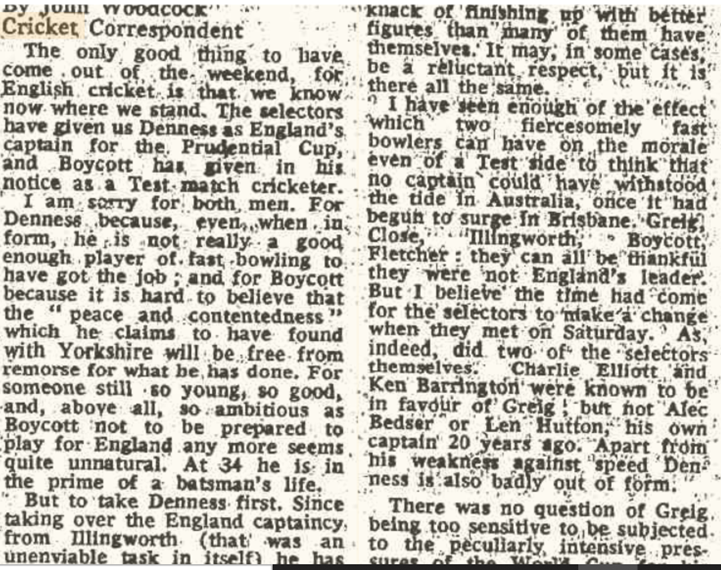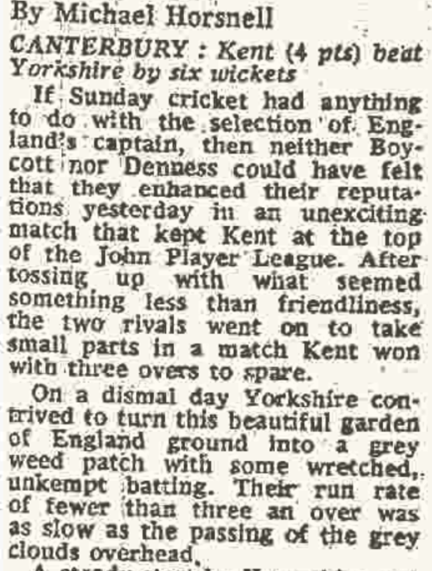24 – 30 May
1975
This was the
first week of the 1975 season that followed the pattern familiar to followers
of county cricket in the seventies: three-day games beginning on Saturday and
Wednesday with a 40-over game interposed on Sunday. For spectators it was a
brilliant arrangement, particularly in Kent where the season was divided
largely into cricket weeks, each at a different venue around the county:
Canterbury, Folkestone, Maidstone and Tunbridge Wells.
For the players,
it looks like madness, more a motoring rally than cricket season, particularly
the year in question when it was decreed that counties should play different
opponents on Sunday to those they were against on Saturday and Monday. So this
week, Yorkshire had to drive down to Edgbaston from Manchester for the Sunday
game, returning to resume the Roses match on Monday; Northamptonshire went from
Leicester to Bristol and back (this on a bank holiday weekend).
The present-day
schedule is much more forgiving, allowing time for travel and preparation (the
latter in 1975 probably being a euphemism for extra drinking). The English season
has been stretched into the extremities of April and September to accommodate this.
Yet still the players complain that there is too much cricket in too short a
time. I have less sympathy than for their (much lower-paid) predecessors. Obviously,
the workload of fast bowlers must be very carefully managed, like lead pitchers
in the MLB, who play once every four or five days. Counties have a duty of care
for all their players, and any deserve a break when their physical or mental
health demands it.
The larger
squads that counties have these days should make that possible without reducing
the number of fixtures. I cannot accept that having to play T20 games on
successive days once or twice a season is an intolerable burden. Even with a
generous margin for wides and no balls, that adds up to no more than 60 balls
for a bowler, about what our baseball pitcher would expect to throw in a game.
There were
hundreds this week for stalwarts of the county game: Roger Tolchard and Jack
Birkenshaw of Leicestershire; Jack Hampshire of Yorkshire; Peter Graves of
Sussex, Dudley Owen-Thomas of Surrey, Phil Slocombe and Brian Close for
Somerset; Alan Jones (not to be confused with Alan Lewis Jones) of Glamorgan; David
Turner of Hampshire; Jim Foat, a folk hero in Gloucestershire (his maiden century);
and Bob Woolmer and Graham Johnson of Kent. Johnson had a fine season in 1975
with 1300 runs and 36 wickets. Had England toured that winter he might well
have been selected. It remains a minor scandal of that time that Geoff Miller
of Derbyshire, a similar player, appeared in 34 tests, while Johnson played in
none. His best form never coincided with a vacancy.
Alan Gibson
was at Bristol for the Jones hundred.
As ever,
Gibson reported on what happened around the ground as well as on the field. He
came across the injured David Shepherd (later a famed umpire), who, he tells
us, “was wearing a sweater of violent purple as though contemplating applying
for a job on The Guardian”.
There were
also centuries for Barry Richards and Alvin Kallicharran, both more than
stalwarts. Richards was reeling them off, and was well ahead of rivals at the
top of the batting averages. And one for Mike Denness, who had whose 171 against
Derbyshire ended a run of indifferent form.
Bowling
performance of the week was by Worcestershire’s Brian Brain, eight for 55 against
Essex. “He looked like a young sociology don at Harvard” wrote Gibson. Despite
this career-best, 34-year-old Brain was released by Worcestershire at the end
of that season, but took a further 316 wickets in six years with
Gloucestershire. His diary of the 1980 season Another Day, Another Match
was an outstanding example of the genre (if anybody has a copy I would be happy
to pay the postage to New Zealand). John Arlott’s brief review in the 1982 Wisden
said that it was “an account of pleasure and pressure; a blend of shrewd and
thoughtful observation; of humour and anxiety; the story of one man’s job – but
a job that is lit by the romanticism which is in every full-time cricketer”.
The same
match saw an achievement that surpassed even Brain’s. Essex leg-spinner Robin
Hobbs took his thousandth first-class wicket. “No other leg-spinner, I am
afraid, will do it again” wrote Gibson, echoing the universal view that
leg-spin was on its way out as surely as black-and-white televisions and half-day
closing. You want to reach back through the years and say “there’s this
five-year-old in Melbourne…”. Of course, as far as English leg-spinners go, it was
a point well-made, though in all forms of the game Adil Rashid is well clear of
a thousand, including, I was surprised to discover, 512 in first-class cricket.
For comparison, there were 18 players listed in the 1975 Playfair with a
thousand wickets at the start of the season. Only Jimmy Anderson is past the
mark in this year’s edition.
It was a
good week for Denness, who was confirmed as England captain for the World Cup. John
Arlott’s Monday commentary in The Guardian tells us that the decision was
not straightforward.
Some of the criteria that got Denness over the line tell us a lot about English cricket at that time: “well turned out…good manners and bearing.” A curiosity is that this was the first time that the selection panel consisted entirely of ex-professional players.
In The
Times, John Woodcock had the inside line on the selection meeting. Reporting
that Charlie Elliott (a test umpire for many years, including one at Lancaster
Park, Christchurch in 1971) and Ken Barrington favoured Greig, while Sir Len
Hutton and Alec Bedser backed Denness. Woodcock favoured Greig, despite his
established reservations about the Sussex all-rounder and his acknowledgement
that others may be relieved that they did not lead MCC in Australia. He is
interesting on Boycott, who announced his unavailability for England selection
hard upon the confirmation of Denness. The claim from the Fitzwilliam Firebrand
that he has found “peace and contentedness” with Yorkshire is hard not to smirk
at when hindsight gives us knowledge of the blood letting that characterised
Yorkshire cricket over the following decade or so. Here is Woodcock’s Monday
commentary in full:
As well as
being cricket correspondent of The Guardian, Arlott was also its wine
writer. This week he offers advice on cooking with wine. He always followed his
own advice that “it is better to be generous than cautious”.
Headline of
the week, from The Times, is as applicable now as it was then:
Why Kent take so long to bowl out the
opposition on good pitches.
Today, the
old county languish at the bottom of Division Two and my Blean Correspondent
and myself fear that it could be the worst season since the annus horribilis of
1980.
The 1975 season had been scheduled as a one with a full tour by South Africa. The World Cup and four-test series with Australia came about with the continued suspension of cricket with the apartheid state. Those who thought that sport was separate from politics might have asked themselves how that could be conceivable under a government that enforced laws in the manner reported by Stanley Uys in The Guardian. Uys, by the way, was described by a minister of the Vorster Government as "probably the most unscrupulous liar in South Africa and a self-confessed traitor", a badge of honour indeed.


















